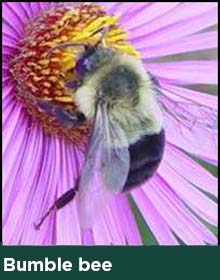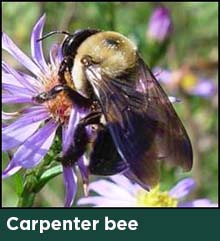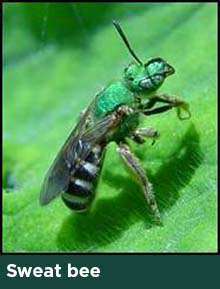Pollination
Why are bees important?
It has often been said that bees are responsible for one out of every three bites of food we eat. Most crops grown for their fruits (including vegetables such as squash, cucumber, tomato and eggplant), nuts, seeds, fiber (such as cotton), and hay (alfalfa grown to feed livestock), require pollination by insects. Pollinating insects also play a critical role in maintaining natural plant communities and ensuring production of seeds in most flowering plants. Pollination is the transfer of pollen from the male parts of a flower to the female parts of a flower of the same species, which results in fertilization of plant ovaries and the production of seeds. The main insect pollinators, by far, are bees, and while European honey bees are the best known and widely managed pollinators, there are also hundreds of other species of bees, mostly solitary ground nesting species, that contribute some level of pollination services to crops and are very important in natural plant communities.
Watch this webinar on smart gardening for bees.
Why are bees good pollinators?
Bees make excellent pollinators because most of their life is spent collecting pollen, a source of protein that they feed to their developing offspring. When a bee lands on a flower, the hairs all over the bees' body attract pollen grains through electrostatic forces. Stiff hairs on their legs enable them to groom the pollen into specialized brushes or pockets on their legs or body, and then carry it back to their nest. Individual bees tend to focus on one kind of flower at a time, which means it is more likely that pollen from one flower will be transferred to another flower of the same species by a particular bee. Many plants require this kind of pollen distribution, known as cross-pollination, in order to produce viable seeds. The business of collecting pollen requires a lot of energy, and so many flowers attract and also reward bees with nectar, a mixture of water and sugars produced by plants.
Where and how do bees live?
Most bee species dig nests in soil, while others utilize plants, either by boring holes in pithy plant stems or wood, or by nesting in galleries made by wood-boring beetles in trees or other preexisting cavities. Bumble bees are known to nest in abandoned rodent burrows and feral honey bees are known to nest in tree hollows. Bees use a variety of materials to build their nests. Most bees line their nest cells with a waxy material they produce themselves, but others use pieces of leaves, small pebbles mixed with resin from tree sap, or mud to form the cells in which they lay their eggs.
Why do bees need flowers throughout the growing season?
Many bee species are solitary (each female produces offspring in her own nest) with only one generation of bees produced per year. However, other species nest communally (several females share a nest) or have elaborate social structures with division of labor within the colony (usually with a single queen and many workers). These kinds of bees produce multiple generations per year. This means that bees that produce multiple generations each year need food resources (pollen and nectar) across most of the growing season to produce strong colonies. Providing plants in a landscape with overlapping bloom periods will help these bees survive and prosper. View our information about selecting plants for overlapping bloom and appeal to pollinators.
Bees need our help!
Bee communities, both wild and managed, have been declining over the last half century as pesticide use in agricultural and urban areas increased. Changes in land use have resulted in a patchy distribution of food and nesting resources. Concerned bee researchers recently met to discuss the current pollinator status in North America and to publish a report about it. Since January (2007), there have been a number of reports in the media about the mysterious disappearance of large numbers of honey bees called colony collapse disorder. This has many growers concerned about how they will continue to be able to pollinate their crops. Now more than ever, it is critical to consider practices that will benefit pollinators by providing habitats free of pesticides, full of nectar and pollen resources, and with ample potential nesting resources.



 Print
Print Email
Email